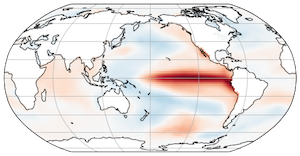Assignment: More Matplotlib
Contents
Assignment: More Matplotlib#
The goal here is to replicate the figures you see as closely as possible.
In order to get some data, you will have to run the code in the cells below. Don’t worry about how this code works. In the end, it will give you some numpy arrays, which you will use in your plots. You are not allowed to use any packages other than numpy and matplotlib to complete your assignment.
Problem 1: Line plots#
In this problem, we will plot some daily weather data from a NOAA station in Millbrook, NY. A full description of this dataset is available at: https://www.ncdc.noaa.gov/data-access/land-based-station-data
The cell below uses pandas to download the data and populate a bunch of numpy arrays (t_daily_min, t_daily_max, etc.) Run the cell and then use the numpy arrays to try to re-create the plot you see.
import pooch
POOCH = pooch.create(
path=pooch.os_cache("noaa-data"),
# Use the figshare DOI
base_url="doi:10.5281/zenodo.5553029/",
registry={
"HEADERS.txt": "md5:2a306ca225fe3ccb72a98953ded2f536",
"CRND0103-2016-NY_Millbrook_3_W.txt": "md5:eb69811d14d0573ffa69f70dd9c768d9",
"CRND0103-2017-NY_Millbrook_3_W.txt": "md5:b911da727ba1bdf26a34a775f25d1088",
"CRND0103-2018-NY_Millbrook_3_W.txt": "md5:5b61bc687261596eba83801d7080dc56",
"CRND0103-2019-NY_Millbrook_3_W.txt": "md5:9b814430612cd8a770b72020ca4f2b7d",
"CRND0103-2020-NY_Millbrook_3_W.txt": "md5:cd8de6d5445024ce35fcaafa9b0e7b64"
},
)
import pandas as pd
with open(POOCH.fetch("HEADERS.txt")) as fp:
data = fp.read()
lines = data.split('\n')
headers = lines[1].split(' ')
dframes = []
for year in range(2016, 2019):
fname = f'CRND0103-{year}-NY_Millbrook_3_W.txt'
df = pd.read_csv(POOCH.fetch(fname), parse_dates=[1],
names=headers, header=None, sep='\s+',
na_values=[-9999.0, -99.0])
dframes.append(df)
df = pd.concat(dframes)
df = df.set_index('LST_DATE')
df
#########################################################
#### BELOW ARE THE VARIABLES YOU SHOULD USE IN THE PLOTS!
#### (numpy arrays)
#### NO PANDAS ALLOWED!
#########################################################
t_daily_min = df.T_DAILY_MIN.values
t_daily_max = df.T_DAILY_MAX.values
t_daily_mean = df.T_DAILY_MEAN.values
p_daily_calc = df.P_DAILY_CALC.values
soil_moisture_5 = df.SOIL_MOISTURE_5_DAILY.values
soil_moisture_10 = df.SOIL_MOISTURE_10_DAILY.values
soil_moisture_20 = df.SOIL_MOISTURE_20_DAILY.values
soil_moisture_50 = df.SOIL_MOISTURE_50_DAILY.values
soil_moisture_100 = df.SOIL_MOISTURE_100_DAILY.values
date = df.index.values
units = lines[2].split(' ')
for name, unit in zip(headers, units):
print(f'{name}: {unit}')

Problem 2: Contour Plots#
Now we will visualize some global temperature data from the NCEP-NCAR atmospheric reanalysis.
import xarray as xr
ds_url = 'http://iridl.ldeo.columbia.edu/SOURCES/.NOAA/.NCEP-NCAR/.CDAS-1/.MONTHLY/.Diagnostic/.surface/.temp/dods'
ds = xr.open_dataset(ds_url, decode_times=False)
#########################################################
#### BELOW ARE THE VARIABLES YOU SHOULD USE IN THE PLOTS!
#### (numpy arrays)
#### NO XARRAY ALLOWED!
#########################################################
temp = ds.temp[-1].values - 273.15
lon = ds.X.values
lat = ds.Y.values

Problem 3: Scatter plots#
Here we will make a map plot of earthquakes from a USGS catalog of historic large earthquakes. Color the earthquakes by log10(depth) and adjust the marker size to be magntiude\(^4\)/100
fname = pooch.retrieve(
"https://rabernat.github.io/research_computing/signif.txt.tsv.zip",
known_hash='22b9f7045bf90fb99e14b95b24c81da3c52a0b4c79acf95d72fbe3a257001dbb',
processor=pooch.Unzip()
)[0]
earthquakes = np.genfromtxt(fname, delimiter='\t')
depth = earthquakes[:, 8]
magnitude = earthquakes[:, 9]
latitude = earthquakes[:, 20]
longitude = earthquakes[:, 21]


